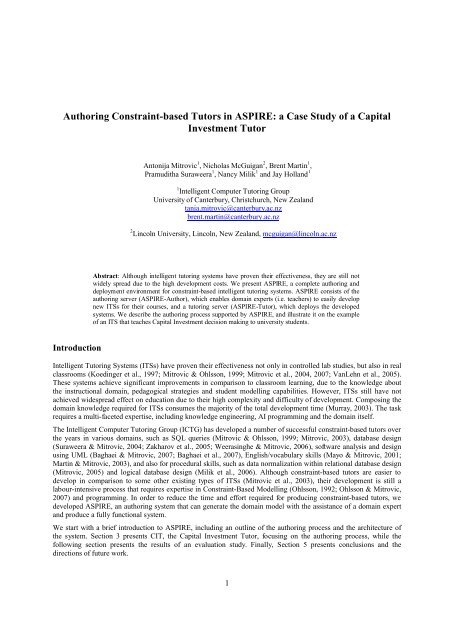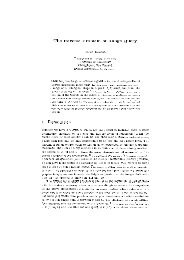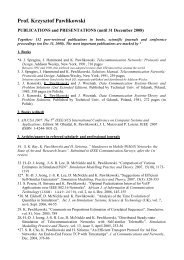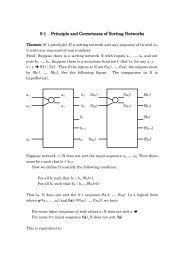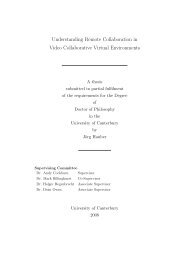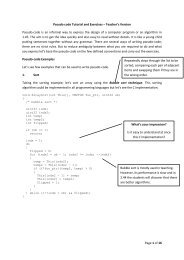a Case Study of a Capital Investment Tutor - Computer Science and ...
a Case Study of a Capital Investment Tutor - Computer Science and ...
a Case Study of a Capital Investment Tutor - Computer Science and ...
You also want an ePaper? Increase the reach of your titles
YUMPU automatically turns print PDFs into web optimized ePapers that Google loves.
Authoring Constraint-based <strong>Tutor</strong>s in ASPIRE: a <strong>Case</strong> <strong>Study</strong> <strong>of</strong> a <strong>Capital</strong><strong>Investment</strong> <strong>Tutor</strong>Antonija Mitrovic 1 , Nicholas McGuigan 2 , Brent Martin 1 ,Pramuditha Suraweera 1 , Nancy Milik 1 <strong>and</strong> Jay Holl<strong>and</strong> 11 Intelligent <strong>Computer</strong> <strong>Tutor</strong>ing GroupUniversity <strong>of</strong> Canterbury, Christchurch, New Zeal<strong>and</strong>tanja.mitrovic@canterbury.ac.nzbrent.martin@canterbury.ac.nz2 Lincoln University, Lincoln, New Zeal<strong>and</strong>, mcguigan@lincoln.ac.nzAbstract: Although intelligent tutoring systems have proven their effectiveness, they are still notwidely spread due to the high development costs. We present ASPIRE, a complete authoring <strong>and</strong>deployment environment for constraint-based intelligent tutoring systems. ASPIRE consists <strong>of</strong> theauthoring server (ASPIRE-Author), which enables domain experts (i.e. teachers) to easily developnew ITSs for their courses, <strong>and</strong> a tutoring server (ASPIRE-<strong>Tutor</strong>), which deploys the developedsystems. We describe the authoring process supported by ASPIRE, <strong>and</strong> illustrate it on the example<strong>of</strong> an ITS that teaches <strong>Capital</strong> <strong>Investment</strong> decision making to university students.IntroductionIntelligent <strong>Tutor</strong>ing Systems (ITSs) have proven their effectiveness not only in controlled lab studies, but also in realclassrooms (Koedinger et al., 1997; Mitrovic & Ohlsson, 1999; Mitrovic et al., 2004, 2007; VanLehn et al., 2005).These systems achieve significant improvements in comparison to classroom learning, due to the knowledge aboutthe instructional domain, pedagogical strategies <strong>and</strong> student modelling capabilities. However, ITSs still have notachieved widespread effect on education due to their high complexity <strong>and</strong> difficulty <strong>of</strong> development. Composing thedomain knowledge required for ITSs consumes the majority <strong>of</strong> the total development time (Murray, 2003). The taskrequires a multi-faceted expertise, including knowledge engineering, AI programming <strong>and</strong> the domain itself.The Intelligent <strong>Computer</strong> <strong>Tutor</strong>ing Group (ICTG) has developed a number <strong>of</strong> successful constraint-based tutors overthe years in various domains, such as SQL queries (Mitrovic & Ohlsson, 1999; Mitrovic, 2003), database design(Suraweera & Mitrovic, 2004; Zakharov et al., 2005; Weerasinghe & Mitrovic, 2006), s<strong>of</strong>tware analysis <strong>and</strong> designusing UML (Baghaei & Mitrovic, 2007; Baghaei et al., 2007), English/vocabulary skills (Mayo & Mitrovic, 2001;Martin & Mitrovic, 2003), <strong>and</strong> also for procedural skills, such as data normalization within relational database design(Mitrovic, 2005) <strong>and</strong> logical database design (Milik et al., 2006). Although constraint-based tutors are easier todevelop in comparison to some other existing types <strong>of</strong> ITSs (Mitrovic et al., 2003), their development is still alabour-intensive process that requires expertise in Constraint-Based Modelling (Ohlsson, 1992; Ohlsson & Mitrovic,2007) <strong>and</strong> programming. In order to reduce the time <strong>and</strong> effort required for producing constraint-based tutors, wedeveloped ASPIRE, an authoring system that can generate the domain model with the assistance <strong>of</strong> a domain expert<strong>and</strong> produce a fully functional system.We start with a brief introduction to ASPIRE, including an outline <strong>of</strong> the authoring process <strong>and</strong> the architecture <strong>of</strong>the system. Section 3 presents CIT, the <strong>Capital</strong> <strong>Investment</strong> <strong>Tutor</strong>, focusing on the authoring process, while thefollowing section presents the results <strong>of</strong> an evaluation study. Finally, Section 5 presents conclusions <strong>and</strong> thedirections <strong>of</strong> future work.1
ASPIREASPIRE consists <strong>of</strong> an authoring server (ASPIRE-Author) which assists the author in developing new ITSs, <strong>and</strong> atutoring server (ASPIRE-<strong>Tutor</strong>) that delivers the resulting ITSs to students (see Figure 1). ASPIRE-Author makes itpossible for the human expert (the author) to describe the instructional domain <strong>and</strong> the tasks the students will beperforming, as well as to specify problems <strong>and</strong> their solutions. Both servers are implemented in Allegro CommonLisp as web servers for users to interact through a st<strong>and</strong>ard web browser. All required domain-dependentinformation, such as the domain model <strong>and</strong> other configuration details produced by ASPIRE-Author, are transferredto ASPIRE-<strong>Tutor</strong> in the XML format. We do not present details <strong>of</strong> ASPIRE in this paper; the interested reader isreferred to (Mitrovic et al., 2006) <strong>and</strong> the ASPIRE Web page (http://aspire.canterbury.ac.nz).Figure 1. The Architecture <strong>of</strong> ASPIREThe authoring process in ASPIRE-Author consists <strong>of</strong> eight steps shown in Figure 2. Initially, the author creates anew domain <strong>and</strong> specifies its general features, such as whether the domain consists <strong>of</strong> a sub-domains focusing onspecific areas, <strong>and</strong> whether the domain is procedural or not. In the case <strong>of</strong> procedural domains, the author is requiredto enumerate the problem-solving steps. The author then describes the domain in terms <strong>of</strong> an ontology (step 2),which identifies the important domain concepts, their properties <strong>and</strong> mutual relationships. In step 3 the authorspecifies the structure <strong>of</strong> problems <strong>and</strong> solutions. The author is then asked to design the student interface (step 4) <strong>and</strong>provide a set <strong>of</strong> problems <strong>and</strong> their solutions (step 5). Syntax constraints are generated automatically (step 6) byanalysing relationships between concepts <strong>and</strong> properties <strong>of</strong> concepts specified in the ontology. The syntax constraintgeneration algorithm extracts the restrictions specified for relationships <strong>and</strong> properties <strong>and</strong> translates them intoconstraints. These constraints are applicable to both procedural <strong>and</strong> non-procedural domains. An extra set <strong>of</strong>constraints are generated for procedural domains to ensure that the student adheres to the correct problem-solvingprocedure. In step 7, ASPIRE generates a set <strong>of</strong> constraints for checking the semantics <strong>of</strong> the answer using amachine-learning technique: alternative (correct) solutions are compared, <strong>and</strong>, if necessary, constraints arespecialized or generalized to be consistent across all the given solutions. Semantic constraints enable the ITS tomodel alternative correct solution approaches. Finally, the author deploys the system in step 8. As the focus <strong>of</strong> thispaper is on CIT, a system developed in ASPIRE, we do not present the details <strong>of</strong> the constraint generationalgorithms; the interested reader is referred to (Suraweera et al., 2005).1. Specifying the domain characteristics2. Composing the domain ontology3. Modelling the problem <strong>and</strong> solution structures4. Designing the student interface5. Adding problems <strong>and</strong> solutions6. Generating syntax constraints7. Generating semantic constraints8. Deploying the tutoring systemFigure 2. The steps <strong>of</strong> the authoring process2
The architecture <strong>of</strong> ASPIRE-<strong>Tutor</strong> is illustrated in Figure 3. The interface module is responsible for producing aninterface for each deployed ITS. The interface provides features such as login/logout, select/changedomains/problems, submit solution for evaluation etc. The session manager is responsible for maintaining the state <strong>of</strong>each student during their interaction. The current session state is described by information such as the selecteddomain, sub-domain <strong>and</strong> problem number. The session manager also acts as the main entry point to the system,invoking the relevant modules when needed. For example, when a student submits a solution to be validated, thesession manager passes on all information to the pedagogical module, which returns the feedback to be presented tothe student. The Pedagogical Module (PM) decides how to respond to each student request. It is responsible forh<strong>and</strong>ing all pedagogy-related requests including selecting a new problem, evaluating a student’s submission <strong>and</strong>viewing the student model. In the event <strong>of</strong> evaluating a student’s submission <strong>and</strong> providing feedback, the PMdelegates the task <strong>of</strong> evaluating the solution to the diagnostic module <strong>and</strong> decides on the appropriate feedback byconsulting the student model. The student modeler maintains a long-term model <strong>of</strong> the student’s knowledge.ASPIRE-<strong>Tutor</strong> serves the developed domain models as web-based tutors. In addition to running a collection <strong>of</strong>tutoring systems in parallel, ASPIRE-<strong>Tutor</strong> also provides the functionality for managing user accounts (foradministrators, teachers, students <strong>and</strong> authors). It also provides functionality for teachers to tailor an ITS to his/herspecific needs for a particular class, <strong>and</strong> allows teachers to assign ITSs to their students.Figure 3. The architecture <strong>of</strong> ASPIRE-<strong>Tutor</strong>ASPIRE has been evaluated in several domains, ranging from fraction addition to thermodynamics <strong>and</strong> engineeringmechanics. In this paper, we present the <strong>Capital</strong> <strong>Investment</strong> Decision; see (Suraweera et al., 2007) for details <strong>of</strong> theevaluations in other instructional domains.CIT - The <strong>Capital</strong> <strong>Investment</strong> <strong>Tutor</strong><strong>Capital</strong> investment decision making plays a crucial role in the financial evaluation <strong>of</strong> non-current assets withincontemporary organisational practice. Our teaching experience shows that capital investment evaluation techniques,namely the accounting rate <strong>of</strong> return, net present value <strong>and</strong> the internal rate <strong>of</strong> return, are problematic for students tomaster. Students find the principles <strong>of</strong> capital investment decision making difficult to comprehend, with a lack <strong>of</strong>ability to translate from theory to practice. It was envisaged that the CIT would enable students to apply theoreticalfinancial decision making to ‘real-life’ simulated business environments.It was with this in mind that the CIT was developed by the second author <strong>of</strong> this paper as one <strong>of</strong> the crucialevaluation stages <strong>of</strong> the ASPIRE project. In this section we describe the process <strong>of</strong> developing CIT.Figure 4 shows a screenshot <strong>of</strong> the Domain tab <strong>of</strong> ASPIRE-Author, which corresponds to the first step <strong>of</strong> theauthoring procedure, in which the author describes the domain <strong>and</strong> specifies problem-solving steps. The task thestudent needs to perform is a procedural one, consisting <strong>of</strong> seven steps. In the first step, the student constructs atimeline <strong>of</strong> project costs from the information given in the problem statement. This step will be shown to the studenton its one, on the first page. In step two (shown on its own on the second page), the student needs to identify therelevant problem type, in terms <strong>of</strong> the variable which needs to be calculated. Step 3 requires the student to select the3
formula corresponding to the chosen variable, <strong>and</strong> then enter the parameters for the formula in step 4. In step 5 thestudent enters the known values into the selected formula, <strong>and</strong> then specifies the computed value in step 6. Based onthe computed value, the student then makes the final decision regarding capital investment in step 7. In CIT, there isonly a single problem set, although ASPIRE allows for multiple problem sets to be definedFigure 4. The steps <strong>of</strong> the <strong>Capital</strong> <strong>Investment</strong> Decision domainThe author then specifies the ontology for this instructional domain. Composing a domain ontology is, in general, amuch easier task for authors than composing constraints manually (Suraweera et al., 2004). ASPIRE-Authorprovides an ontology workspace for visually modelling ontologies (Figure 5). The ontology describes the domain byidentifying important concepts <strong>and</strong> relationships between them. The ontology outlines the hierarchical structure <strong>of</strong>the domain in terms <strong>of</strong> sub- <strong>and</strong> super-concepts; for example, the Cash Flow concept in Figure 5 is specialised intoinitial, operating <strong>and</strong> terminal cash flows. Each subconcept inherits the properties <strong>of</strong> its parent concept, but alsomight have its own properties, <strong>and</strong> may be related to other domain concepts. The specialization relationshipsbetween domain concepts are visually represented as arrows between concepts. The Cash Flow concept is thecurrently selected concept in Figure 5, <strong>and</strong> its properties (Amount <strong>and</strong> Period) are shown in the table below.In the third authoring step, the author specifies the problem/solution structures. Problems can consist <strong>of</strong> components(textual or graphical) <strong>and</strong> a problem statement. In our domain, each problem has a problem statement <strong>and</strong> an attachedphotograph. For each step <strong>of</strong> the procedure, the student’s solution might contain one or more components. Theoverall structure <strong>of</strong> solutions depends on whether the domain is procedural or not. The solution structure for capitalinvestment decision making is outlined in Figure 6.The student interface needs to be designed next. The final outcome <strong>of</strong> this phase is an interface in which studentscompose their solutions to problems. ASPIRE generates a default interface, which is form-based, by placing an inputarea for each component defined in the solution structure. The author can replace one or more pages with Javaapplets, which might be more suited to the task the student is performing than a textual interface. We developed twoapplets for CIT, which will be discussed later. After designing the student interface, the author entered twelveproblems <strong>and</strong> their solutions. In this domain, there is only one correct solution per problem; in other domains, theremight be multiple correct solutions, <strong>and</strong> in such cases the author would need to specify all valid solutions, which areused by the authoring system to generate semantic constraints.4
Figure 5. Ontology for the <strong>Capital</strong> <strong>Investment</strong> domainOnce example problems <strong>and</strong> their solutions are available, ASPIRE-Author generates the domain model. In case <strong>of</strong>CIT, there are 34 syntax <strong>and</strong> 25 semantic constraints generated. Syntax constraints check whether the student’ssolution follows the syntactic rules <strong>of</strong> the domain; they make sure that all the necessary solution components arespecified, that they are <strong>of</strong> appropriate types, <strong>and</strong> are related to other solutions components as necessary. Figure 7illustrates one syntax constraint, which checks whether the student has specified one part <strong>of</strong> the solution (operationalcash flows). The author cannot change the constraint itself, but can modify the feedback messages attached to it, totailor them in order to be more underst<strong>and</strong>able to students in comparison to the automatically generated feedbackmessages.Problem solving stepSolution components1. Construct a timeline Cash flows (initial, operating <strong>and</strong> terminal)2. Identify problem type One <strong>of</strong> Accounting Rate <strong>of</strong> Return, Bond, Future Value, Internal Rate <strong>of</strong> Return,Net Present Value (NPV), Payback Period3. Select the formula One <strong>of</strong> the pre-specified set <strong>of</strong> formulae4. Specify the parameters for the formula n, k5. Complete the formula All components <strong>of</strong> the NPV formula6. Enter the NPV value NPV value7. Make the final decision DecisionFigure 6. Solution structure for CIT5
Figure 7. A syntax constraint from CITFinally, the author deploys the domain, which results in the domain information being transferred to ASPIRE-Author. The ITS is immediately available for the author to try out. The author/teacher can also define one or moregroups, consisting <strong>of</strong> students who will have access to the system. The teacher can tailor the behaviour <strong>of</strong> the systemto his/her needs. For example, the teacher can specify the feedback levels to be <strong>of</strong>fered, as well as the progressionbetween them. ASPIRE <strong>of</strong>fers the following feedback levels: Quick Check (specifying whether the answer is corrector not), Error Flag (identifying only the part <strong>of</strong> the solution that is erroneous), Hint (identifying the first error <strong>and</strong>providing information about the domain principle that is violated by the student’s solution), Detailed Hint (a moredetailed version <strong>of</strong> the hint), All Errors (hints about all errors) <strong>and</strong> Show Solution. By default, ASPIRE starts withQuick Check <strong>and</strong> progresses with each consecutive submission to the same problem to Detailed Hint, unless thestudent asks for a specific type <strong>of</strong> feedback. Information about all errors <strong>and</strong> the solution are only available atrequest. However, the teacher can override this default behaviour by limiting the types <strong>of</strong> feedback, prohibiting thefull solution from being shown, specifying the minimal number <strong>of</strong> attempts before the full solution can be seen, or byspecifying the maximal level <strong>of</strong> feedback to be provided automatically. The teacher can also specify the problemselection mechanisms available to students.Figure 8 shows the student interface with the applet for the first step in CIT. The top area <strong>of</strong> the page providescontrols for selecting problems, obtaining help, <strong>and</strong> changing/leaving the ITS. The problem statement is showntogether with the photo describing the situation. The problem-solving area for this step consists <strong>of</strong> an applet,visualizing the time line. The student needs to label the periods on this timeline, <strong>and</strong> enter the amounts correspondingto the various types <strong>of</strong> cash flows. In the situation illustrated in Figure 8, the student has incorrectly labelled theinitial time as period 1 on the timeline, entered the incorrect value for the initial cash flow, <strong>and</strong> has not specified therest <strong>of</strong> the timeline. The feedback shown in the right-h<strong>and</strong> panel corresponds to the All Errors level: the first hintdiscusses operating cash flows that are missing, the second one discusses the initial cash flow for which the studentsupplied the wrong value (3,5000 instead <strong>of</strong> 10,000 as specified in the problem text), while the last one discusses theterminal cash flow. The first <strong>and</strong> third hints come from violated syntax constraints, while the second one comes froma violated semantic constraint. The student can change the solution based on the feedback provided, <strong>and</strong> submit thesolution to CIT again.Since CIT is a procedural tutor, the student needs to complete each step correctly before being allowed to move on tothe following step. Figure 9 shows a situation when the student has already completed the first four stepssuccessfully: the student has completed the timeline, selected NPV as the appropriate evaluation mechanism to beused in the problem, selected the correct formula for NPV, <strong>and</strong> specified the correct values for n (the number <strong>of</strong>years) <strong>and</strong> k (the interest rate), which are the parameters used in the formula for NPV. The applet shows the currentstep, in which the student is to fill in the values into the formula for calculating NPV. Please note that the appletshows the exp<strong>and</strong>ed version <strong>of</strong> the summation formula, showing the four terms corresponding to the operating cashflows <strong>and</strong> the last term (pi) corresponding to the initial cash flow. The goal <strong>of</strong> this step is to check whether thestudent can differentiate between the initial cash flow (the term subtracted from the others) from the operating cashflows, <strong>and</strong> also whether the student underst<strong>and</strong>s the various time periods involved <strong>and</strong> corresponding cash flows. Thestudent has specified the initial cash flow correctly, but has not specified any <strong>of</strong> the operating cash flows <strong>and</strong> the6
corresponding time periods. The feedback shown in Figure 9 is on the Hint level, <strong>and</strong> discusses the operating cashflows which are missing from the student’s solution.Figure 8. Student interface showing the first step <strong>of</strong> the procedure (the timeline)We have chosen to develop applets for these steps to make CIT visually more attractive, although the task itself canbe executed using purely textual input. However, in other domains it might be impossible to use a textual interface.For example, if the student needs to develop some kind <strong>of</strong> diagram, a drawing applet would be necessary. Ourexperience shows that the time <strong>and</strong> effort needed to develop applets is higher than the requirements for the otherdevelopment tasks in ASPIRE. Additionally, applets require s<strong>of</strong>tware engineering experience, <strong>and</strong> for that reason wedo not expect teachers to be able to develop applets by themselves.Evaluation <strong>Study</strong>We trialled CIT in May 2007 in ACCT102, Accounting <strong>and</strong> Finance for Business, an introductory business decisionmaking course taught at the Lincoln university. There were 32 students who volunteered to participate in this study.The students have listened to lectures covering the relevant material before using the system. The students used CITduring scheduled tutorials <strong>of</strong> 50 minutes. During this time, the students sat a short pre-test, interacted with thesystem, <strong>and</strong> then sat a post-test <strong>and</strong> filled in a user questionnaire. The average interaction time with CIT was only 30minutes. The mean results on the pre-test was 25% (sd=14%), while the students achieved significantly higher results(p=0.07) on the post-test with the mean <strong>of</strong> 35% (sd=31%). We attribute the relatively low results on the post-test tothe short session length.7
Figure 9. Student interface showing the fifth step <strong>of</strong> the problem0.30.25ErrorProb0.20.150.1y = 0.2579x -0.3771R 2 = 0.93080.0501 2 3 4 5 6 7 8OccasionFigure 10. The learning curve from the CIT study8
We have performed a preliminary analysis <strong>of</strong> the data collected during the study. Figure 10 shows the learning curve.The x-axis shows the opportunity to use a specific knowledge element (i.e. constraint) during the session. The y-axisshows the probability <strong>of</strong> making errors on the same knowledge elements. The data points were averaged over allconstraints <strong>and</strong> all students who interacted with CIT. The data points have an excellent fit to the power curve,showing that students do learn effectively in CIT. Furthermore, the learning rate (i.e. the exponent <strong>of</strong> the powercurve equation) is very high, showing that students acquire the necessary knowledge fast. The initial error probability<strong>of</strong> 0.27 dropped by more than 50% to 0.12 after only eight attempts on average, which is a significant result,especially taking into account that the session length was short. The students’ comments from the questionnaire showthat the students enjoyed interacting with the system <strong>and</strong> believed that their underst<strong>and</strong>ing <strong>of</strong> the domain wasimproved as a consequence <strong>of</strong> using CIT. The students pointed out the usefulness <strong>of</strong> feedback in correcting theirmistakes. We plan to repeat the evaluation study in early 2008, with longer sessions (2 hours). In the next study, wewill compare the learning performance <strong>of</strong> students using CIT to that <strong>of</strong> students learning in a traditional way, in agroup situation with a human tutor.ConclusionsWe provided an overview <strong>of</strong> ASPIRE, an authoring system that assists domain experts in building constraint-basedITSs <strong>and</strong> serves the developed tutoring systems over the web. ASPIRE follows a semi-automated process forgenerating domain models, in which the author is required to provide a description <strong>of</strong> the domain in terms <strong>of</strong> anontology, specify the structure <strong>of</strong> problems <strong>and</strong> solutions, <strong>and</strong> provide examples <strong>of</strong> both. From this information,ASPIRE induces the domain model, <strong>and</strong> produces a fully functional web-based ITS, which can then be used bystudents. ASPIRE also provides additional support for administrators to create user accounts <strong>and</strong> maintain theactivities in ASPIRE. It also supports teachers in tailoring ITSs to their classes. The paper presented the process <strong>of</strong>developing CIT, an ITS that teaches <strong>Capital</strong> <strong>Investment</strong> decision making, in ASPIRE. We discussed the phases <strong>of</strong>CIT’s development, as well as the result <strong>of</strong> a preliminary evaluation, which showed that the students do learn frominteracting with CIT. We plan to conduct a longer study <strong>of</strong> CIT effectiveness.CIT is only one <strong>of</strong> the ITSs developed in ASPIRE. We have also been developing ITSs in ASPIRE for the areas <strong>of</strong>thermodynamics, engineering mechanics, chemistry <strong>and</strong> arithmetic. The authors involved in this work have varioustypes <strong>of</strong> backgrounds, ranging from teachers to <strong>Computer</strong> <strong>Science</strong> postgraduate students. Our experiences show thatalthough initially authors need to learn about ontologies <strong>and</strong> the development philosophy supported by ASIRE, theyfind it a flexible <strong>and</strong> powerful tool. ASPIRE is freely available on the Web, <strong>and</strong> we do hope that other teachers willbe using it to develop ITSs for their courses.AcknowledgementsThe ASPIRE project was supported by the eCDF grants 502 <strong>and</strong> 592 from the Tertiary Education Commission <strong>of</strong>New Zeal<strong>and</strong>. We thank all members <strong>of</strong> ICTG for their support.ReferencesBaghaei, N., Mitrovic, A. & Irwin, W. (2007) Supporting Collaborative Learning <strong>and</strong> Problem-Solving in a Constraint-basedCSCL Environment for UML Class Diagrams. <strong>Computer</strong>-Supported Collaborative Learning, 2(2-3), 159-190.Baghaei, N., Mitrovic, A. (2007) From Modelling Domain knowledge to Metacognitive Skills: Extending a Constraint-based<strong>Tutor</strong>ing System to Support Collaboration. User Modeling 2007, 217-227.Koedinger, K. R., Anderson, J. R., Hadley, W. H., & Mark, M. A., (1997) Intelligent <strong>Tutor</strong>ing goes to School in the Big City.Artificial Intelligence in Education, 8, 30-43.Mayo, M. & Mitrovic, A. (2001) Optimising ITS Behaviour with Bayesian Networks <strong>and</strong> Decision Theory’. Artificial Intelligencein Education, 12(2), 124-153.Martin, B. & Mitrovic, A. (2003) Domain Modeling: Art or <strong>Science</strong>? Artificial Intelligence in Education 2003, IOS Press, 183-190.9
Milik, N., Marshall, M., Mitrovic, A. (2006) Responding to Free-form Student Questions in ERM-<strong>Tutor</strong>. Intelligent <strong>Tutor</strong>ingSystems 2006, 707-709.Mitrovic, A. (2003) An Intelligent SQL <strong>Tutor</strong> on the Web. Int. J. Artificial Intelligence in Education, 13(2-4), 173-197.Mitrovic, A. (2005) The Effect <strong>of</strong> Explaining on Learning: a <strong>Case</strong> <strong>Study</strong> with a Data Normalization <strong>Tutor</strong>. Artificial Intelligencein Education 2005, IOS Press, 499-506.Mitrovic, A. & Ohlsson, S. (1999) Evaluation <strong>of</strong> a Constraint-Based <strong>Tutor</strong> for a Database Language. Artificial Intelligence inEducation, 10(3-4), 238-256.Mitrovic, A., Koedinger, K. & Martin, B. (2003) A Comparative Analysis <strong>of</strong> Cognitive <strong>Tutor</strong>ing <strong>and</strong> Constraint-Based Modelling.User Modeling 2003, Springer-Verlag, pp. 313-322.Mitrovic, A., Suraweera, P., Martin, B. & Weerasinghe, A. (2004) DB-suite: Experiences with Three Intelligent, Web-basedDatabase <strong>Tutor</strong>s. Journal <strong>of</strong> Interactive Learning Research, 15, 409-432.Mitrovic, A., Suraweera, P., Martin, B., Zakharov, K., Milik, N. & Holl<strong>and</strong>, J. (2006) Authoring Constraint-based <strong>Tutor</strong>s inASPIRE. Intelligent <strong>Tutor</strong>ing Systems 2006, 41-50.Mitrovic, A., Martin, B. & Suraweera, P. (2007) Intelligent <strong>Tutor</strong>s for all: Constraint-based Modeling Methodology, Systems <strong>and</strong>Authoring. IEEE Intelligent Systems, 22(4), 38-45.Murray, T. (2003) An Overview <strong>of</strong> Intelligent <strong>Tutor</strong>ing System Authoring Tools: Updated Analysis <strong>of</strong> the State <strong>of</strong> the Art.Authoring tools for advanced technology learning environments. 491-545.Ohlsson, S. (1992) Constraint-based student modeling. Artificial Intelligence <strong>and</strong> Education, 3(4), 429-447.Ohlsson, S. & Mitrovic, A. (2007) Fidelity <strong>and</strong> Efficiency <strong>of</strong> Knowledge Representations for Intelligent <strong>Tutor</strong>ing Systems.Technology, Instruction, Cognition <strong>and</strong> Learning, 5(2), 101-132.Suraweera, P. & Mitrovic, A., (2004) An Intelligent <strong>Tutor</strong>ing System for Entity Relationship Modelling. Artificial Intelligence inEducation, 14, 375-417.Suraweera, P., Mitrovic, A. & Martin, B. (2004) The Role <strong>of</strong> Domain Ontology in Knowledge Acquisition for ITSs. Intelligent<strong>Tutor</strong>ing Systems ITS 2004, Springer-Verlag, 207-216.Suraweera, P., Mitrovic, A. & Martin, B. (2005) A Knowledge Acquisition System for Constraint-based Intelligent <strong>Tutor</strong>ingSystems. Artificial Intelligence in Education, IOS Press, 638-645.Suraweera, P., Mitrovic, A., Martin, B. (2007) Constraint Authoring System: an empirical evaluation. Proc. 13 th Int. Conf.Artificial Intelligence in Education AIED 2007, 451-458.VanLehn, K., Lynch, C., Schulze, K., Shapiro, J.A., Shelby, R., Taylor, L., Treacy, D., Weinstein, A. & Wintersgill, M. (2005).The Andes Physics <strong>Tutor</strong>ing System: Lessons Learned. Artificial Intelligence in Education, 15, 147-204.Weerasinghe, A., Mitrovic, A. (2006) Facilitating Deep Learning through Self-Explanation in an Open-ended Domain.Knowledge-based <strong>and</strong> Intelligent Engineering Systems, IOS Press, 10(1), 3-19.Zakharov, K., Mitrovic, A., Ohlsson, S. (2005) Feedback Micro-engineering in EER-<strong>Tutor</strong>. Artificial Intelligence in Education2005, IOS Press, 718-725.10


